🔹 Revenue: $15.19B (Est. $14.76B) 🟢
🔹 EPS: $2.38 (Est. $1.16) 🟢
Guidance (reiterated, CER):
🔹 FY25 Total Revenue: high single-digit % growth
🔹 FY25 Core EPS: low double-digit % growth

Puestos
30$BNTX (+1,26 %)
$ON (+5,48 %)
$HIMS (-1,79 %)
$PLTR (-8,17 %)
$O (+0,6 %)
$8058 (+0,81 %)
$7974 (+0,42 %)
$BP. (+3,13 %)
$BOSS (+0,37 %)
$SWK (+2,1 %)
$SPOT (-0,53 %)
$N1CL34
$UBER (+1,61 %)
$CPRI (-0,44 %)
$SHOP (-5,64 %)
$RACE (-1,19 %)
$HOG (-0,35 %)
$HTZ (-0,91 %)
$PFIZER
$UPST (-0,49 %)
$ANET (-0,77 %)
$PINS
$TEM (+0,94 %)
$AMD (+3,82 %)
$SMCI (+2,45 %)
$RIVN (-5,69 %)
$BYND (-0,79 %)
$KTOS (+3,66 %)
$CPNG (-4,59 %)
$BMW (+2,73 %)
$NOVO B (+1,14 %)
$FRE (-2,05 %)
$ORSTED (+5,44 %)
$AG1 (+2,59 %)
$EVT (+1,3 %)
$CCO (+6,26 %)
$DOCN (-0,18 %)
$LMND (+6,41 %)
$SONO (+0,66 %)
$MCD (-1,16 %)
$HOOD (-1,58 %)
$QCOM (-0,4 %)
$FTNT (-2,71 %)
$FSLY (+0,24 %)
$HUBS (-3,46 %)
$ELF (-3,15 %)
$ARM (+4,2 %)
$SNAP (+3,57 %)
$DASH (-4,09 %)
$APP (-11 %)
$AMC (-0,98 %)
$ZIP (-3,82 %)
$FIG (+0 %)
$LCID (+0,53 %)
$DUOL
$UN0 (+3,94 %)
$CBK (+1,32 %)
$DEZ (+1,89 %)
$ZAL (-1,98 %)
$HEN (+0,5 %)
$MAERSK A (+1,31 %)
$HEI (-0,43 %)
$CON (+0,82 %)
$AZN (-0,73 %)
$ALB (-0,35 %)
$MRNA (-0,69 %)
$QBTS (+6,2 %)
$WBD (-0,45 %)
$LI (+1,9 %)
$RHM (+3,09 %)
$DDOG (-2,42 %)
$RL (+2,22 %)
$OPEN (+4,98 %)
$ABNB (-2,28 %)
$PTON (-2,31 %)
$MP (+6,33 %)
$TTD (-1,12 %)
$STNE (+0,34 %)
$SQ (-0,85 %)
$GRND (+0 %)
$IREN (+8,25 %)
$AFRM (-1,07 %)
$CRISP (-0,14 %)
$RUN (-0,83 %)
$7011 (-0,71 %)
$DTG (+1,05 %)
$HAG (+4,05 %)
$DKNG (+4,12 %)
$LAC (+5,71 %)
$KKR (-0,5 %)
$PETR3 (+3,58 %)
$CEG
$WEED (-1,85 %)
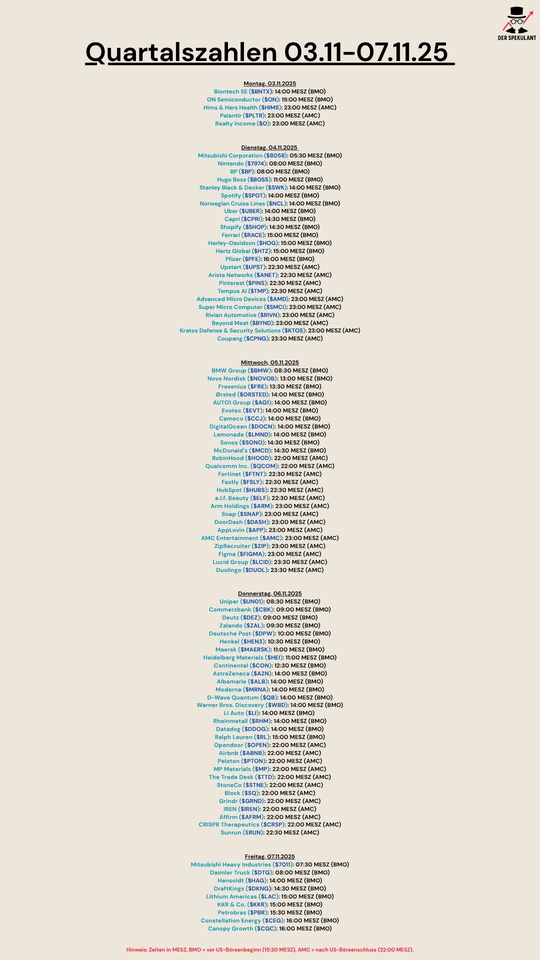
The 17 largest pharmaceutical companies were written to and given a deadline of September 29 to lower their prices, otherwise Trump himself will come by. 😈
The S&P500 pharma sector was the weakest sector today with -2.2 %.


$HEIA (+0,03 %)
$EL (-1,38 %)
$NUE (+2,58 %)
$CDNS (-1,68 %)
$WM (-1,55 %)
$MSFT (-2,41 %)
$V (-1,75 %)
$OR (-0,24 %)
$AZN (-0,73 %)
$MRK (+0,33 %)
$PG (-1,3 %)
$SBUX (-1,35 %)
$BCS (+1,83 %)
$META (-0,91 %)
$BABA (+4,98 %)
$QCOM (-0,4 %)
$AIR (+3,05 %)
$HSBC (+1,1 %)
$GSK (+0,38 %)
$MBG (+2,48 %)
$F (+0,74 %)
$AAPL (-0,45 %)
$AMZN (-1,83 %)
$MA (-1,99 %)
$7203 (+0,86 %)
$SHEL (+2,78 %)
$005930
$SNY (-0,96 %)
$CMCSA (+0,17 %)
$COIN (+1,61 %)
$NET (-0,9 %)
$XOM (+1,83 %)
$CVX (+3,11 %)
$CS (+0,28 %)
$NTDOY (+0,35 %)
$CL (-2,73 %)
$DTG (+1,05 %)
$UNH (+2,52 %)
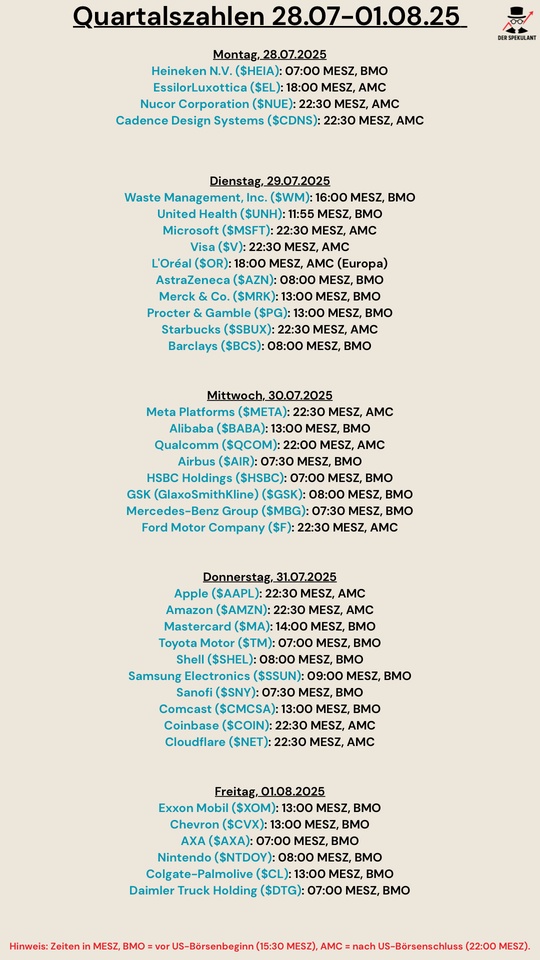
The $C (+0,77 %) currently recommends the FTSE 100, as it is well suited as a hedge against the risk in the Middle East. This is illustrated by 3 factors.
𝖢𝗂𝗍𝗂𝗀𝗋𝗈𝗎𝗉 𝗌𝗂𝖾𝗁𝗍 𝖻𝗋𝗂𝗍𝗂𝗌𝖼𝗁𝖾 & 𝖲𝖼𝗁𝗐𝖾𝗂𝗓𝖾𝗋 𝖠𝗄𝗍𝗂𝖾𝗇 𝗌𝗈𝗐𝗂𝖾 𝖤𝗇𝖾𝗋𝗀𝗒 𝗎𝗇𝖽 𝖽𝖾𝖿𝖾𝗇𝗌𝗂𝗏𝖾 𝖲𝖾𝗄𝗍𝗈𝗋𝖾𝗇 𝖺𝗅𝗌 𝗉𝗈𝗍𝖾𝗇𝗓𝗂𝖾𝗅𝗅𝖾 𝖮𝗎𝗍𝗉𝖾𝗋𝖿𝗈𝗋𝗆𝖾𝗋, 𝖿𝖺𝗅𝗅𝗌 𝖽𝗂𝖾 𝗀𝗅𝗈𝖻𝖺𝗅𝖾𝗇 𝖱𝗂𝗌𝗂𝗄𝖾𝗇 𝗐𝖾𝗂𝗍𝖾𝗋 𝗌𝗍𝖾𝗂𝗀𝖾𝗇.
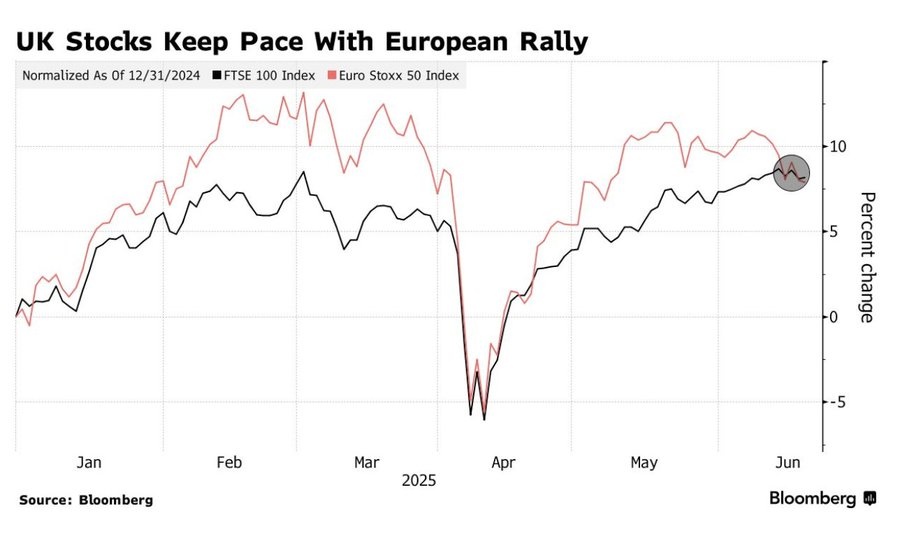
🧬 BICO
$BICO (-3,76 %) has been on my watchlist since my early days on getquin.
In 2021, the company was on everyone's lips, celebrated as the company of the future in bioprinting.
But what followed was a classic hype cycle: the share price rose rapidly, was cheered by quite a few "finfluencers" and then plummeted just as sharply.
Many people got their fingers burnt back then. What remains is the image of an overvalued tech fantasy, fueled by empty promises and loud voices without substance.
And yet: The company has remained. So has the vision, and in recent months a lot seems to have changed structurally.
Today, more than 80 % below its all-time high, the question arises anew:
Is BICO simply an overrated stock market experiment...
... or is the current valuation realistic for the first time and BICO on the way to translating its technological substance into a genuine business model?
Over the past few weeks, I have been taking a closer look at the company's structure, history and current developments, including the latest figures [1] and the earnings call [2] from 29.04.25.
In this article, I share my collected insights, thoughts and assessments for those who also have the company on their watchlist.
As always:
No investment advice. I don't want to contribute to more burnt fingers, but to encourage reflection.
Have fun!
BICO Group AB (formerly CELLINK) is a Swedish life science company founded in 2016.
The original innovation: a biocompatible ink for 3D printing of living cells, a small revolution in research.
Today, BICO stands for a big goal: Bioconvergence.
This means merging biology, technology, software and automation to make research, diagnostics and drug development faster, cheaper and more efficient.
What is the vision and how does BICO make money?
The vision: The laboratory of the future. Automated, networked, efficient with AI, robotics and bioprinting.
This is how BICO earns money today:
Share of Sales 2024:
Excursus
Bioprinting:
BICO was with CELLINK was one of the first suppliers worldwide to offer bioprinters plus matching "bioinks" commercially.
The basic idea:
Bioink and what it is made of:
Bioink is a gel-like substance that is mixed with living cells. It contains, for example:
This matrix keeps the cells alive and makes it possible to print biologically active structures, e.g. tissue samples, tumor models or skin structures.
Is this already being done today or is it all future?
Yes, it is being done, but not clinically.
Bioprinting is currently being used, for example:
What is not yet possible:
Because...
🔮 Future potential: unrealistic or groundbreaking
If bioprinting really breaks through in medicine, we will be talking about one of the biggest breakthroughs of the 21st century:
RealisticFirst functional organs could be available in 10 -20 years clinically relevant, but first in small pilot studies or animal models.
Are there any research results or publications on this?
Yes, BICO (especially CELLINK) is a regular co-author or technology partner in publications.
Especially in areas such as:
Several universities and research institutions use the BIO X printers, including for example MIT and Harvard
Trusted partners:
Digression Conclusion
Bioprinting sounds like science fiction and yes, it is a long way from everyday transplantation. But in research and diagnostics it is real, applicable and in demand.
__________
History in brief From bioink to platform
New CEO since 2024: Maria Forss
Maria Forss brings decades of experience from leading life science companies:
At Vitrolife (2018 - 2023), she led global expansion and M&A projects, including the billion-euro deal with Igenomix. Prior to that (2014 - 2018), she was at Elekta (radiotherapy, oncology) where she was responsible for global marketing and product strategies.
She started her career at AstraZenecawhere she gained international experience in sales, regulatory affairs and market launch. There she learned what makes large pharmaceutical companies tick, particularly in terms of approval, market launch and regulatory navigation
She is an expert in:
The retirement of founder Gatenholm points to a clear change in strategy, away from visionary, growth-driven development and towards cost control, profitability and integration.
In the Earnings Call Q1 2025 Forss emphasizes several times:
"We have implemented a new operational structure, are harmonizing global functions and are focusing on efficiency and selected growth areas."
📊 Q1 2025 in figures and what's really behind it (Caution currency: Swedish krona, 1 SEK ~ 0.10 USD)
Supplement:
Q1 is seasonally weak as many customers (especially in research) do not make large investments at the beginning of the year. At the same time, Q4 was strong, which pulled sales forward.
Comparison of the three previous segments (Q1 2025)
With a view to organic growth:
👩🔬 Life Science Solutions:
🧬 Bioprinting:
🔬Lab Automation:
What do the individual divisions do?
👩🔬 Life Science Solutions:
This is where BICO develops laboratory technologies for diagnostics and cell research, such as devices for high-precision dosing of tiny quantities of liquids, consumables and special analysis platforms.
Examples:
Cancer diagnostics:
Allergy tests:
Genetic testing & DNA analysis:
Point-of-care diagnostics:
🧬 Bioprinting (see excursus above)
🔬 Lab automation
This is about the complete automation of laboratories, e.g. robots that create cell cultures, carry out analyses or coordinate samples. Everything is controlled centrally via the Green Button Go® software from Biosero.
💰 How profitable is BICO currently?
BICO is not yet profitable in the traditional sense, as EBIT (operating result) was clearly negative at SEK -290 million in 2024.
However, the operating cash flow a completely different picture: this was 2024 positive at SEK +259 million, as well as in Q1 2025 at +77 MSEK.
This means that BICO is now earning money in its core business, meaning that liquidity is flowing into the company.
The EBIT is still burdened by high depreciation and amortization on earlier acquisitions, research expenditure and, in some cases, one-off restructuring costs.
Conclusion
up to here:
BICO is not yet "through", but the path to operational profitability is recognizable. The company is heading in the right direction, now it depends on whether it can stabilize its operating base and continue to scale its high-margin business areas.
🤝 Business divisions & restructuring (from Q2 2025)
BICO previously operated in 3 segments:
New from Q2 2025:
Only two divisions, as Bioprinting will be integrated into "Life Science Solutions". Why?
Because CELLINK & Co. are now closely interlinked with diagnostics and consumables. The new setup is intended to increase efficiency, leverage synergies and simplify reporting.
📊 Classification of the figures and why Lab Automation is not growing, even though it is strategically so important
Bioprinting & Life Science Solutions show positive organic growth, while Lab Automationthe third-largest division, shrank massively (-58%).
Automation in particular is one of the main growth drivers in the bioconvergence strategy.
Explanation according to earnings call:
Q1 2024 (PY) was an upward outlier:
Fewer project starts and completions in Q1 2025:
Macro-related reluctance on the part of major customers (pharma):
According to CEO Maria Forss:
"The underlying demand for Lab Automation continues to be strong."
"Project cycles are longer - but demand from pharma remains intact."
Project business is naturally volatile:
BICO's strategic response
Standardization of project packages:
Strengthening project management:
Focus on pharmaceutical customers:
➡️ The decline in sales in Lab Automation looks dramatic, but is primarily due to timing and not a structural problem.
BICO is responding with strategic adjustments to its product portfolio and points to continued strong demand, only with longer lead times.
For investors, this means that the decline is unfavorable but explainable, not alarming
Further statements from the earnings call
CEO Maria Forss:
"Despite a decline in sales, Life Science Solutions and Bioprinting are showing positive development. Our strategy adjustment is taking effect."
Why is bioprinting booming right now?
Excursus in-vitro tissue models:
"In vitro" means: outside the living body, e.g. in a petri dish, on a chip or in a laboratory device.
Tissue models are replicated biological structures that resemble real human (or animal) tissue.
Example:
A skin tissue printed with cells that is used for cosmetic or drug tests, without animal testing.
What's the point?
In vitro tissue models are an ethically and scientifically attractive alternative to animal testing and BICO supplies the printing technology for this, among other things.
Is BICO a unique company in bioprinting?
No, but one of the pioneers with a broad portfolio.
There are competitors such as Allevi, Aspect Biosystems and Organovo, but BICO combines hardware, software and services under one roof - a strategic advantage.
Where does the market currently stand and what does the future look like?
Possible future scenarios
1 . BICO becomes a global playerBICO continues to grow, automates laboratories worldwide
2 . BICO becomes a takeover candidate: Groups such as Sartorius $SRT (+0,99 %) , Danaher $DHR (+0,62 %) or Thermo Fisher $TMO (+2,32 %) could strike
3 . BICO remains niche leader: Focused on profitable segments with high innovation density
Risks & critical voices
The topic of the convertible bond has made me sit up and take notice again; here are some more deep dives:
What's the deal with BICO's convertible bonds until 2026?
Convertible bonds are a kind of hybrid between a bond and a share. They work like this:
At the end of the term (March 2026), investors receive either:
The whole thing is attractive for companies because they:
What this means in concrete terms:
Why is this an issue for investors
1 . Repayment or dilution:
If BICO cannot repay the amount, new shares must be issued, this is called dilution because your stake in the company decreases.
2 . Cash flow burden:
If BICO wants to repay the amount from its own resources, it needs a lot of liquidity, which can slow down other investments.
3 . Refinancing risk:
If the market is weak in 2025/26, refinancing could become expensive or not possible at all.
What is the current situation?
Positive:
Statement on financing / repayment
CFO Jacob Thornberg said:
"The closing of the divestment of MatTek and Visikol for USD 80 million is expected to take place during Q2 2025 [...]
The proceeds from the transaction will be used to resolve the outstanding convertible bond, which matures in March 2026."
Translated:
The entire proceeds from the sale of MatTek & Visikol to Sartorius (USD 80 million) are earmarked for the repayment of the convertible bond.
Management's assessment of the financial position:
"We expect to move into a net cash position during Q2 2025."
This means:
Assessment: How credible is this?
Positive:
-> Repayment can be financed if no new setback occurs
But:
➡️ Management is actively pursuing the plan to redeem the convertible bond in full before maturity in 2026 without dilution.
The sale of MatTek & Visikol has freed up concrete capital for this.
The direction is right, but BICO remains a risky stock with operational debt.
More on profitability:
In the Q1 2025 Earnings Call BICO's management did not give a specific date for break-even or profitability
... which is typical for growth companies with highly volatile project business.
What was said instead?
On profitability in Q1 itself:
EBITDA was negative (SEK -12m), but:
"Adjusted EBITDA was in line with Q1 2024 due to the positive development in Life Science Solutions and Bioprinting."
-> Improvement due to mix effects and operational measures
Long-term statements?
No specific annual figure or guidance on profitability. But:
"We have launched a new operating model [...] to achieve improved commercial as well as operational efficiencies."
"We will continue to optimize our cost base and drive efficiency through integration."
Interpretation:
The focus is on the short term:
Butunfortunately no clear words like: "We plan to be profitable in 2025 or 2026." 😬
Will BICO be the company that prints organs, or is it more likely to be taken over?
Technologically, BICO is very well positioned today when it comes to bioprinting infrastructure:
ButPrinting fully functional organs for clinical applications is a gigantic leap, not only technologically, but also in regulatory, medical and logistical terms. This is what is needed:
These are competencies that are more common in corporations like Johnson & Johnson $JJ, Medtronic $MDT (-0,71 %) , GE Healthcare $GEHC (+0,34 %)
, Siemens Healthineers $SHL (-1 %) or Thermo Fisher $TMO not a smaller platform provider like BICO.
Which is more likely?
1 . BICO remains the "toolmaker" of the bioprinting world:
Just like ASML for semiconductors or Illumina for genomics, but without building drugs/organs itself.
2 . BICO will be taken over when the topic becomes clinically concrete:
For example, when the first major organ projects enter the clinical phase, it is likely that a giant will strike to secure access to the technology.
3 . BICO remains an enabler, but not the final provider of clinical bioprinted organs
When organs are actually printed, will BICO become the global market leader?
🏷️ Unlikely.
➡️ More realistic is that BICO becomes one of the key technology suppliers or is taken over by one of the big players beforehand.
This can still be highly attractive for investors. After all, whoever supplies technology will be needed, regardless of who ends up operating on the patient.
Should we now focus on BICO or rather on a large corporation with bioprinting potential? 🤔
1 . Buy BICO for speculative returns
Pros:
Contra:
2 . Alternatively: back a large corporation for more stability
Which big players have the potential to drive bioprinting forward (or take over BICO)?
Sartorius
-> Best-case candidate for takeover or joint venture
Thermo Fisher Scientific
-> Comes into play when bioprinting is more closely integrated into pharmaceutical production
Danaher
-> Could strike when the market matures, but rather late and strategically
3D Systems / Stratasys
-> Riskier than classic medtechs, but a direct bioprinting play
Personal classification: substance or science fiction on credit?
What makes more strategic sense? Which investment is "the right one"?
OR
Combination strategy:
I invest a small position in BICO as a "moonshot", combine this with a solid underlying position in Sartorius or Thermo Fisher and cover the technology and protect the capital if BICO fails.
The two underlying positions mentioned can of course also represent a global ETF.
My personal assessment of BICO currently fluctuates between cautious optimism and realistic doubt.
On the one hand, I see a clear technological lead and a strategy that, unlike a year or two ago, now appears more well thought-out and focused. Partnerships with established players such as Sartorius also give me the feeling that BICO is not operating alone in a vacuum.
On the other hand, the operational foundation is still shaky. Profitability has not been achieved and the issue of the 2026 convertible bond hangs over the company.
Without sufficient cash flow or fresh capital, the ambitious vision could stumble, and despite all the enthusiasm for bioprinting and automation, we should always be aware of this.
BICO is not a stock for quiet nights, but for visionaries with patience it may be a ticket to the future of medicine.
I am currently waiting for an entry opportunity with a good feeling. The goal could be a portfolio share of up to approx. 3-4%, which then remains in place and is reduced in the future through portfolio growth without selling.
Thanks for reading! 🤝
______________
Sources:
[1] https://storage.mfn.se/5a3030c0-d13b-4177-80d0-94da59c7302d/bico-q1-2025-eng.pdf
[2] https://bico.events.inderes.com/q1-report-2025/register
/ https://web.quartr.com/link/companies/4484/events/247443/transcript?targetTime=0.0
More:
https://www.sartorius.com/en/company/investor-relations
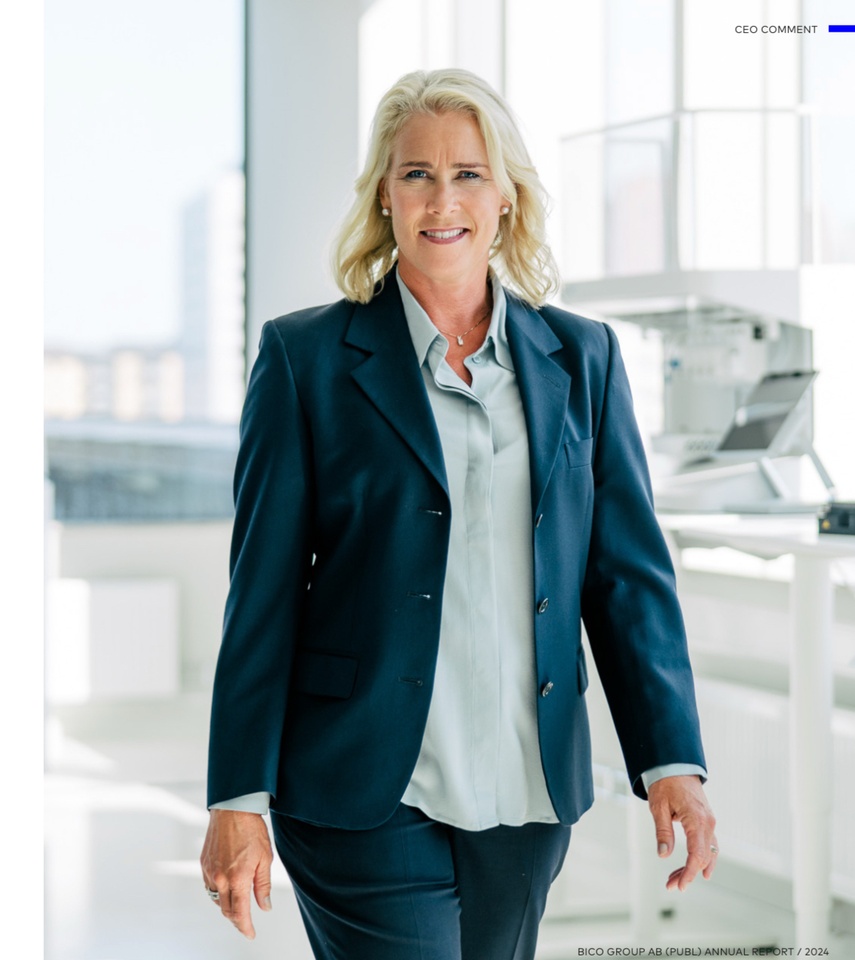
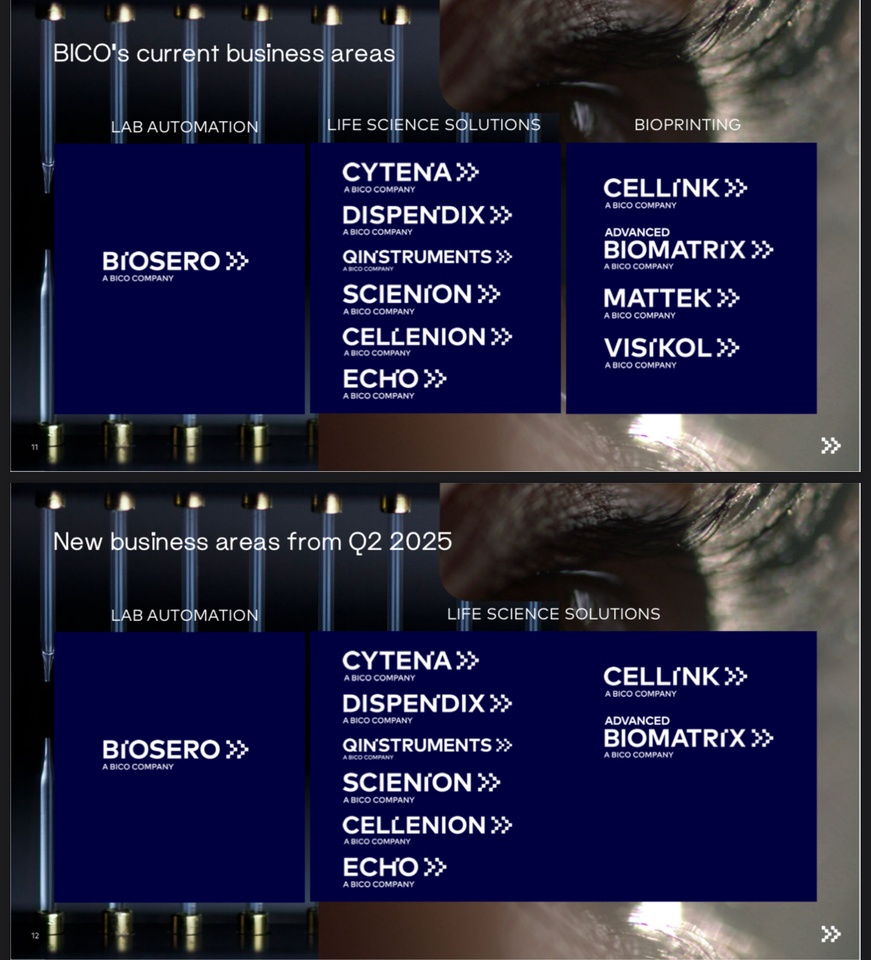
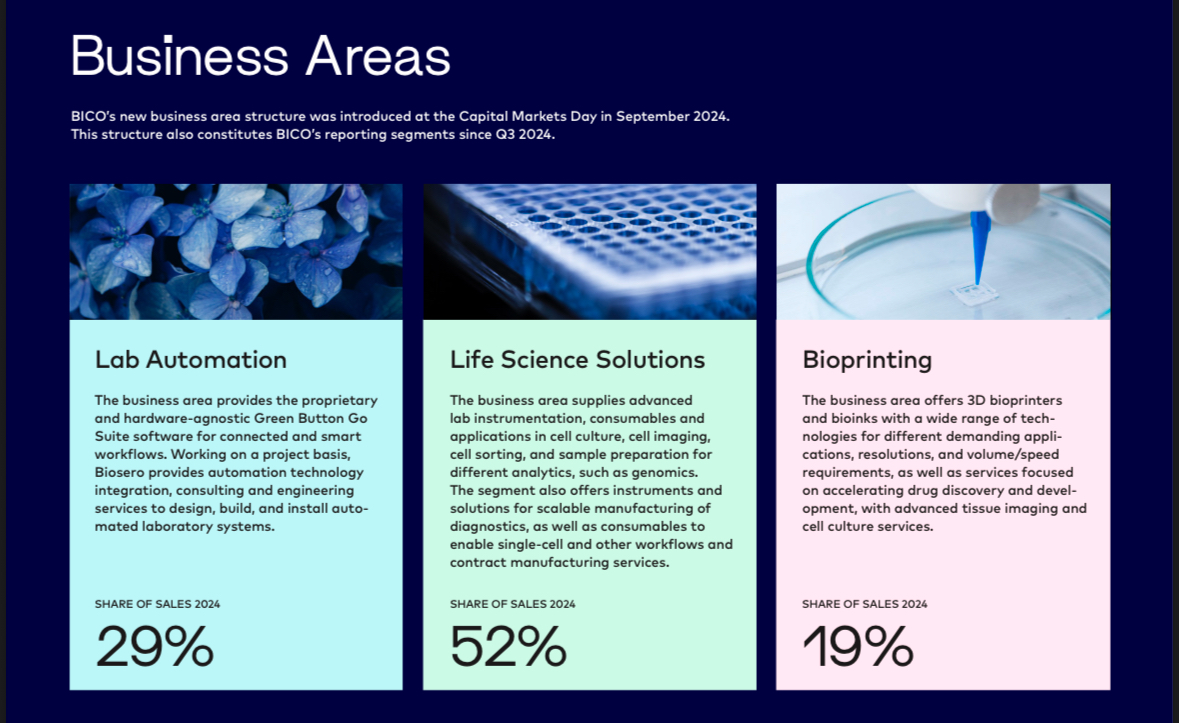
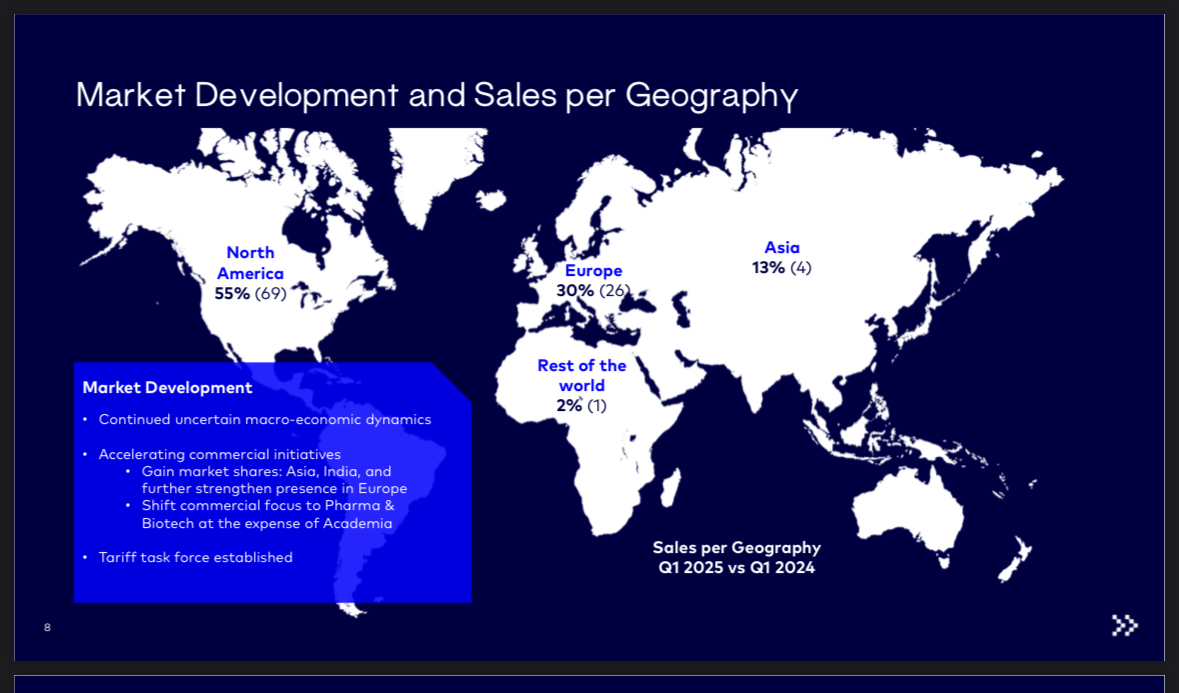
Good evening everyone,
Here are my favorites for the health sector.
Novo Nordisk $NOVO B (+1,14 %)
Stryker $SYK (+0,07 %)
Intuitive Surgical (P/E ratio 70, P/B ratio 19 🤑) $ISRG (-1,95 %)
Astra Zeneca $AZN (-0,73 %)
Zoetis $ZTS (+0,21 %)
Idexx Lab. $IDXX (-1,47 %)
Amgen (profit margin declining) $AMGN (-0,04 %)
I would be interested to know what your favorites are for a long-term investment?
I would like to use the current "black time" to structure my portfolio better and diversify it more. So far, I have overweighted some sectors rather arbitrarily, while others are completely absent. 😅
In order to achieve a more sound, sectoral diversification, I have looked at two things:
1. the long-term performance of the sectors in the S&P 500
2. the maximum drawdowns of these sectors over different time periods
----------------------------------------------------------------------------------------------------------
The following table shows the average annual returns of the S&P 500 sectors over 10, 20, 30 and 40 years.
It is striking: Some sectors have performed significantly better than others over longer periods of time. Particularly noteworthy are
- Information technology
- Healthcare
- Consumer staples (cyclical consumption)
These sectors achieved long-term average annual returns of over 10% p.a.
By contrast, the following sectors performed less convincingly:
- Energy
- Materials (basic materials)
- Real estate
----------------------------------------------------------------------------------------------------------
Unfortunately, historical drawdown data by sector is limited and not uniformly available. Nevertheless, a clear trend can be identified: The available data shows that defensive sectors tend to have lower drawdowns, while cyclical sectors are more prone to larger declines. So it looks like sectors such as consumer discretionary and healthcare tend to have lower maximum drawdowns, while sectors such as financials and energy have had the sharpest declines.
In the next step, I looked at the current (2024) market weighting of the sectors in the S&P 500, i.e. a market capitalization-weighted allocation as a passive ETF would reflect it:
Information Technology 28%
Healthcare 13 %
Financial services 12 %
Consumer Discretionary 10%
Communication services 8 %
Industry 8 %
Consumer staples 6 %
Energy 4 %
Utilities 3 %
Materials 2.5 %
Real estate 2.5 %
This is the first time I realize how much you have to overweight or underweight a sector in order to have the greatest probability of hypothetically beating the market in a fictitious, ideal scenario by means of sectoral overweighting and underweighting.
For example, only a weighting of well over 28% in information technology would have led to a possible outperformance.
Conversely, only a complete abandonment of the real estate sector could have made a positive contribution. (in retrospect)
Of course, this is a gross oversimplification, as each sector consists of a large number of companies of very different quality. Nevertheless, valuable insights for the strategic portfolio orientation can be derived from this.
----------------------------------------------------------------------------------------------------------
But now I'm at a crossroads.
Option A
I analyze current valuation ratios such as P/E ratios, Shiller P/E ratios or earnings growth per sector and decide on this basis which sectors appear most attractive for the future, i.e. an active, forward-looking approach.
Option B (my favorite):
I take my cue from long-term, historical average returns and risks and use them as a guide for strategic allocation - in other words, a more rule-based approach with a rational derivation.
----------------------------------------------------------------------------------------------------------
My sectoral target portfolio, based on risk-return profile and personal preference, could look like this:
Let's start from the back, the weakest sectors such as energy, real estate, utilities and basic materials have proven to be underperforming and often volatile over the long term. In total, I would therefore like to limit these to a maximum of 10% of my portfolio.
Industry 8 %
Financial services with 9 %
Communication services 10 %
Consumer staples with 13 %,
Healthcare 15 %
Consumer staples 15%
Information technology 20 %
The above weighting aims to create a portfolio that is both growth-oriented and risk-optimized in the long term.
----------------------------------------------------------------------------------------------------------
Conclusion 🤓
With this train of thought, I am pursuing a systematic and long-term approach that takes both opportunities and risks into account. The aim is to create a portfolio that remains stable and profitable in different market phases. Of course, it will not always be easy to implement these weightings perfectly in practice, but this strategy provides a clear direction as a basis.
----------------------------------------------------------------------------------------------------------
Sources 🤯
JP Morgan Asset Management - Guide to the Markets
www.vanguard.com Principles for Investing Success
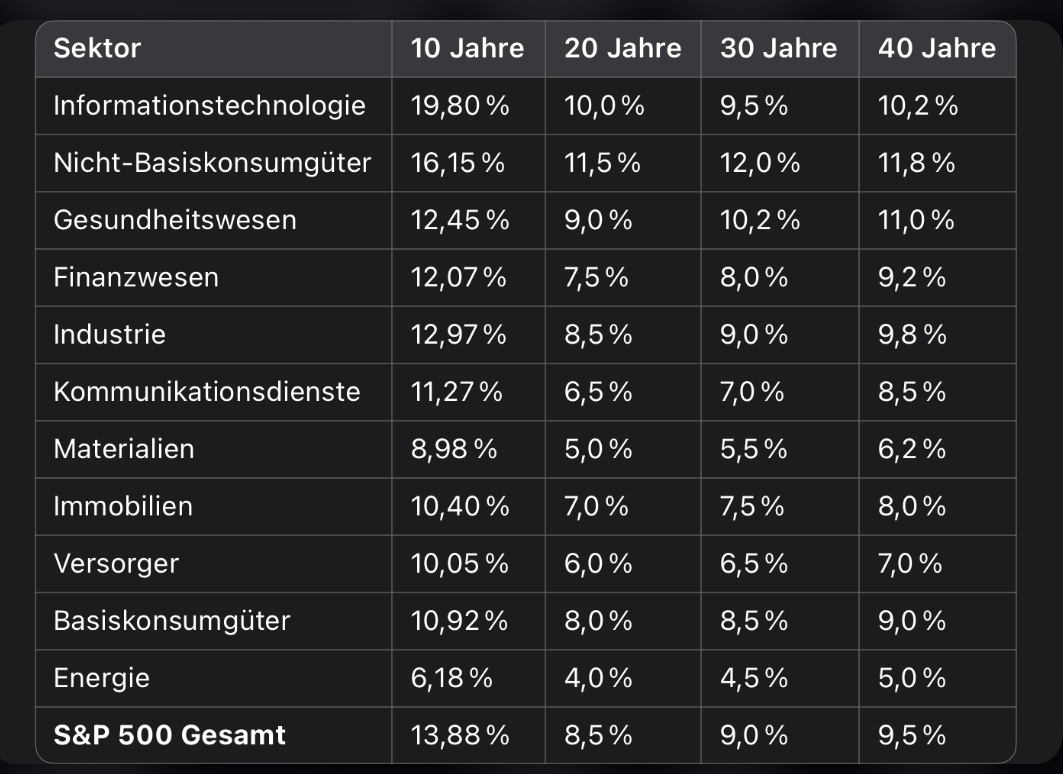
The AstraZeneca share $AZN (-0,73 %) is currently in a positive state. The pharmaceutical company has published promising results on a new drug for the treatment of breast cancer, Camizestrant. These data come from a phase III trial and show a significant extension of the period without disease progression.
The trial is still ongoing and it is likely to be some time before approval. However, analysts are optimistic and forecast sales of USD 1.5 billion (EUR 1.4 billion) for Camizestrant by 2030.
AstraZeneca even expects peak annual sales of USD 5 billion for the drug, which would be a great success. Group CEO Pascal Soriot recently emphasized that the company's drug pipeline is well on track, which is reflected in sales growth of 18% in 2024 to over USD 54 billion.
AstraZeneca shares rose by 1.5% to £120.32 in London trading. It remains exciting to see how developments will continue! 📈
⬆️⬆️⬆️
- GOLDMAN raises the price target for SIEMENS ENERGY from EUR 56 to EUR 60. Buy. $ENR (+2,4 %)
- BARCLAYS raises the target price for MERCEDES-BENZ from EUR 48.50 to EUR 50. Underweight. $MBG (+2,48 %)
- JEFFERIES upgrades SMA SOLAR from Hold to Buy and raises target price from EUR 14 to EUR 20. $S92 (+5,19 %)
- GOLDMAN raises the price target for DEUTSCHE BÖRSE from EUR 226 to EUR 231. Neutral. $DB1 (-2,53 %)
- BOFA upgrades BBVA from Neutral to Buy and raises target price from EUR 11 to EUR 13. $BBVA (+1,92 %)
- WARBURG RESEARCH upgrades FUCHS SE from Hold to Buy. Target price EUR 50. $FPE
- GOLDMAN raises the price target for FLATEXDEGIRO from EUR 17 to EUR 18. Buy. $FTK (-0,38 %)
- BERENBERG raises the target price for IBERDROLA from EUR 12.30 to EUR 14. Hold. $IBE (+1,96 %)
- JEFFERIES upgrades PVA TEPLA from Hold to Buy and raises target price from EUR 12 to EUR 19. $TPE (+3,07 %)
- JEFFERIES raises the price target for FRIEDRICH VORWERK from EUR 23 to EUR 30. Hold. $VH2 (+3,78 %)
- JEFFERIES raises the price target for ZEAL NETWORK from EUR 45 to EUR 58. Buy. $TIMA (-4,36 %)
- JEFFERIES raises the price target for ADESSO from EUR 75 to EUR 85. Hold. $ADN1 (+0,06 %)
- JEFFERIES upgrades NEL from Underperform to Hold. Target price NOK 3. $NEL (+2,01 %)
⬇️⬇️⬇️
- BERENBERG lowers the price target for RWE from EUR 46.50 to EUR 42. Buy. $RWE (+3,71 %)
- GOLDMAN lowers target price for EON from EUR 17.50 to EUR 17. Buy. $EOAN (+2,2 %)
- HAUCK AUFHÄUSER IB downgrades AIXTRON from Buy to Hold and lowers target price from EUR 26.40 to EUR 13.80. $AIXA (+13,52 %)
- METZLER lowers the price target for DWS from EUR 41 to EUR 40.50. Hold. $DWS (-0,53 %)
- GOLDMAN lowers the price target for ASTRAZENECA from GBP 159.55 to GBP 155.58. Buy. $AZN (-0,73 %)
- TD COWEN downgrades STMICRO to Hold. Target price EUR 24.50. $STM (+3,56 %)
- JPMORGAN downgrades CONSTELLATION BRANDS to Neutral. Target price USD 203. $STZ (+2,37 %)
- JEFFERIES lowers the price target for DOCMORRIS from CHF 65 to CHF 39. Buy. $DOCM (+0,28 %)
- JEFFERIES lowers the price target for ATOSS SOFTWARE from EUR 112 to EUR 108. Hold. $AOF (-1,82 %)
- JEFFERIES lowers the price target for JENOPTIK from EUR 34 to EUR 29. Buy. $JEN (+3,06 %)
- JEFFERIES lowers the price target for KONTRON from EUR 29 to EUR 27. Buy. $KTN (+1,84 %)
- JEFFERIES lowers the price target for SILTRONIC from EUR 95 to EUR 90. Buy. $WAF (+3,97 %)
- JEFFERIES downgrades VERBIO from Buy to Hold and lowers target price from EUR 22 to EUR 11. $VBK (+5,49 %)
- JEFFERIES downgrades SGL CARBON from Buy to Hold and lowers target price from EUR 9.50 to EUR 4.40. $SGL (+0,88 %)
⬆️⬆️⬆️
- BOFA raises the price target for WALMART from USD 95 to USD 105. Buy. $WMT (+0,48 %)
- JEFFERIES raises the price target for WALMART from USD 100 to USD 105. Buy. $WMT (+0,48 %)
- HAUCK AUFHÄUSER IB raises the target price for RHEINMETALL from EUR 680 to EUR 750. Buy. $RHM (+3,09 %)
- WARBURG RESEARCH raises the target price for RHEINMETALL from EUR 600 to EUR 700. Buy. $RHM (+3,09 %)
- JPMORGAN raises the price target for SALESFORCE from USD 310 to USD 340. Overweight. $CRM (-4,37 %)
- WARBURG RESEARCH raises the target price for LEG IMMOBILIEN from EUR 81.60 to EUR 90.50. Hold. $LEG (-0,85 %)
- DEUTSCHE BANK RESEARCH raises the price target for HEIDELBERG MATERIALS from EUR 116 to EUR 137. Buy. $HEI (-0,43 %)
- KEPLER CHEUVREUX raises the price target for GFT TECHNOLOGIES from EUR 31 to EUR 32. Buy. $GFT (+0 %)
- ODDO BHF raises the target price for TALANX from EUR 76 to EUR 78. Underperform. $TLX (-1,14 %)
- KEPLER CHEUVREUX raises the target price for THYSSENKRUPP from EUR 3.70 to EUR 3.80. Hold. $TKA (+4,1 %)
⬇️⬇️⬇️
- STIFEL lowers the price target for BAYER from EUR 36 to EUR 28. Hold. $BAYN (+2,93 %)
- LBBW downgrades ENI from Buy to Hold and lowers target price from EUR 16.70 to EUR 15. $ENI (+2,56 %)
- WARBURG RESEARCH lowers the target price for SFC ENERGY from EUR 29 to EUR 27. Buy. $F3C (+2,33 %)
- WARBURG RESEARCH lowers the target price for TECHNOTRANS from EUR 23 to EUR 21. Buy. $TTR1 (+0,87 %)
- DEUTSCHE BANK RESEARCH lowers the price target for CUREVAC from USD 3.90 to USD 2.50. Hold. $CVAC (+8,69 %)
- BERENBERG lowers the price target for ASTRAZENECA from GBP 150 to GBP 140. Buy. $AZN (-0,73 %)
Principales creadores de la semana